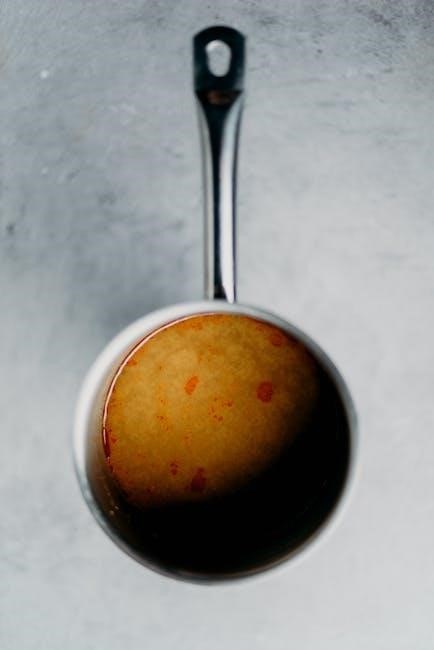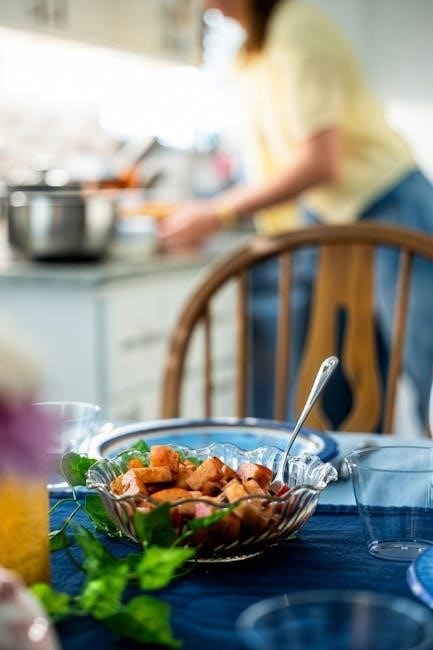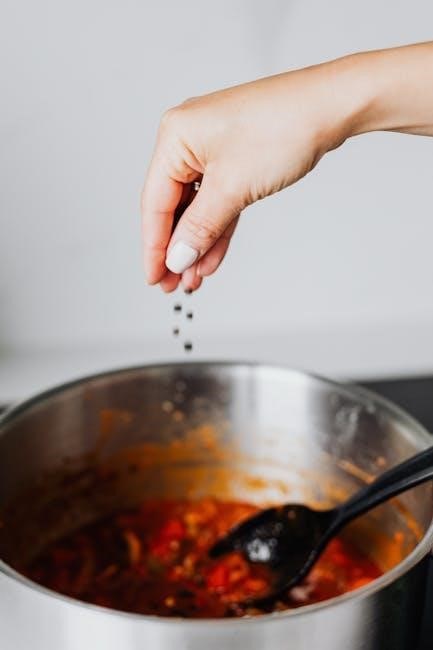Welcome to the Belling Range Cooker Instructions Manual! This guide provides essential information for safe installation, operation, and maintenance of your cooker. Discover tips for optimal performance and troubleshooting to enhance your cooking experience.
1.1 Overview of Belling Range Cookers
Belling range cookers are high-quality appliances designed for versatility and durability. Available in various models, such as the Farmhouse and Cookcentre series, they offer advanced features like multiple ovens, separate grills, and multi-zone hobs. These cookers cater to diverse cooking needs, whether you prefer gas or electric options. With sleek designs and finishes like cream or charcoal, Belling range cookers blend functionality with style, making them a perfect addition to modern kitchens. Their robust construction ensures long-lasting performance, while innovative features enhance your cooking experience.
1.2 Importance of Reading the Manual
Reading the Belling range cooker manual is crucial for safe and effective operation. It provides essential safety guidelines, installation tips, and maintenance advice. Understanding the control panel and features ensures optimal performance. The manual also offers troubleshooting solutions and warranty details. By following the instructions, you can prevent accidents, extend the appliance’s lifespan, and make the most of its capabilities. Familiarizing yourself with the manual helps you navigate features like multi-zone hobs, ovens, and grills efficiently, ensuring a seamless cooking experience while adhering to manufacturer recommendations.
Safety Precautions and Guidelines
Always follow safety guidelines to ensure safe operation. Keep children away, avoid flammable materials nearby, and ensure proper ventilation. Regularly inspect gas and electrical connections for leaks or damage; Adhere to manufacturer instructions to prevent accidents and maintain appliance efficiency.
2.1 General Safety Information
Ensure safety by keeping children away from the cooker and avoiding flammable materials nearby. Always turn off the appliance when not in use and never leave cooking unattended. Regularly inspect the cooker for damage or wear, and follow the manufacturer’s guidelines for operation. Proper ventilation is essential to prevent carbon monoxide buildup. Avoid using damaged cables or plugs, and never attempt repairs yourself. Adhering to these precautions will help prevent accidents and ensure efficient, safe operation of your Belling range cooker.
2.2 Electrical Safety Tips
Always ensure your Belling range cooker is installed by a qualified electrician to meet safety standards. Avoid overloading circuits and use the correct rated cable. Keep the cooker dry and never operate it with wet hands. Do not use damaged plugs or cables, as this can cause electrical hazards. Ensure the appliance is properly grounded and disconnect it when not in use. Follow the manufacturer’s guidelines for electrical connections to prevent shocks or fires. Regularly inspect electrical components for wear and tear to maintain safety.
2.3 Gas Safety Precautions
Ensure your Belling range cooker’s gas connection is installed by a Gas Safe registered professional. Always check for gas leaks by applying soapy water to connections—bubbles indicate a leak; Keep the area well-ventilated to prevent carbon monoxide buildup. Never use the cooker if you suspect a gas leak; turn off the supply immediately. Avoid leaving cooking unattended, especially when using gas burners. Follow the manufacturer’s guidelines for ignition and flame adjustment. Regularly inspect hoses and connections for wear and tear. In case of emergencies, turn off the gas supply and contact a professional.
Installation and Setup
Proper installation ensures safe and efficient operation of your Belling range cooker. Follow the manual’s guidelines for unpacking, placement, and connecting electrical and gas components. Ensure all connections are secure and meet safety standards to avoid hazards and optimize performance.
3.1 Unpacking and Placement
Carefully unpack your Belling range cooker, ensuring all components are undamaged. Place it on a heat-resistant, level surface, away from flammable materials. Ensure proper clearance around the cooker for ventilation. Use the adjustable feet to level the appliance, ensuring stability. Refer to the manual for specific placement recommendations based on your model, such as the Farmhouse 90DFT or Cookcentre 110E. Proper placement is crucial for safe operation and optimal performance of your cooker.
3.2 Electrical Connections
Connect your Belling range cooker to a suitable electrical supply, ensuring compliance with local regulations. Use a qualified electrician for hardwired models. The cooker requires a 230V, 30-45A power supply, depending on the model. For electric models like the Cookcentre 110E, ensure the circuit can handle the maximum power load. Avoid using extension cords and keep the cooker away from water sources. Refer to your specific model’s manual for exact electrical requirements. Proper installation ensures safe and efficient operation of your Belling range cooker.
3.3 Gas Line Installation
Ensure your Belling range cooker’s gas line installation is performed by a qualified technician to meet safety standards. Use approved materials and follow local gas regulations. For models like the Farmhouse 90DFT, connect the gas supply to the designated inlet, ensuring compatibility with your gas type (Natural Gas or LPG). After installation, test for leaks using a soap solution. Proper connections are crucial for safe operation. Refer to your manual for specific requirements and recommendations for your model. Always prioritize safety when handling gas lines.
3.4 Ventilation Requirements
Proper ventilation is essential for safe and efficient operation of your Belling range cooker. Install an extractor fan or chimney-style hood at least 75cm above the hob to remove cooking fumes. Ensure good airflow by keeping kitchen windows or vents open. For gas models, adequate ventilation prevents carbon monoxide buildup. Refer to your manual for specific recommendations tailored to your cooker model. Poor ventilation can lead to reduced performance and safety hazards, so prioritize a well-ventilated cooking environment.
Operating the Belling Range Cooker
This section guides you through operating your Belling range cooker, including understanding the control panel, using the oven, hob, grill, and setting the timer and clock effectively.
4.1 Understanding the Control Panel
The control panel is your command center for operating the Belling range cooker. It features intuitive buttons, knobs, and digital displays for selecting oven functions, adjusting temperatures, and controlling hob zones. Familiarize yourself with the layout to access features like oven timers, grill activation, and heat distribution settings. The panel also includes indicators for active elements and error codes. For models with advanced features, explore touch controls and preset cooking modes. Understanding the control panel ensures seamless operation and enhances your cooking experience with precision and ease.
4.2 Using the Oven
Preheat the oven to the desired temperature before cooking. Select from modes like conventional, fan-assisted, or grill for optimal results. Use the control panel to set the timer and monitor cooking progress. Place food in the center of the oven rack for even heat distribution. Avoid overcrowding to ensure consistent cooking. For specific models, refer to the manual for unique features like slow cooking or defrosting. Always use oven mitts when handling hot dishes. Regular cleaning prevents food residue buildup, maintaining efficiency and hygiene.
4.3 Operating the Hob
To operate the hob, ensure the area is clear of flammable materials. For gas hobs, turn the knob and press the ignition button. Adjust the flame size as needed. For electric or ceramic hobs, select the desired zone and set the heat level using the control panel. Always use cookware with a flat base for even heat distribution. Avoid overheating by monitoring the cooking process. Keep children away while the hob is in use. Refer to your model’s specific features, such as multiple cooking zones or booster functions, for enhanced cooking flexibility and efficiency.
4.4 Grill Functionality
The grill function on your Belling range cooker allows for precise control over cooking. Preheat the grill before use for even browning. Use the dedicated grill controls to adjust heat settings, ensuring optimal results. Place food in the center of the grill pan for uniform cooking. Always use oven gloves to handle hot grill pans. Avoid leaving the grill unattended, especially when cooking fatty foods. Regularly clean the grill and pan to prevent food residue buildup. For energy efficiency, preheat only when necessary and cook in batches if needed. This feature enhances your cooking versatility and delivers professional-grade results.
4.5 Timer and Clock Settings
Set the clock by pressing the clock button and using the +/- controls. The timer helps manage cooking times precisely. Press the timer button, set the desired duration, and start. The cooker will alert you when the timer expires. Use the timer for oven, grill, or hob tasks. Preheat the oven using the timer for optimal results. Ensure the clock is correctly set for accurate timer functionality. Regularly check and adjust the clock during daylight saving changes. This feature streamlines your cooking process, ensuring dishes are perfectly timed and cooked to perfection every time.
Maintenance and Cleaning
Regular cleaning prevents food residue buildup. Wipe the hob and burners daily with a damp cloth. Use gentle cleaners for the oven and exterior. Check parts regularly for optimal performance.
5.1 Daily Cleaning Tips
Daily cleaning is essential to maintain your Belling range cooker’s performance. Wipe the hob and burners with a damp cloth after each use to prevent food residue buildup. For the oven, use a gentle cleaner and avoid abrasive materials to protect the enamel. Remove and clean racks regularly, and always allow surfaces to cool before cleaning. Regular wipedowns of exterior surfaces with a soft cloth will keep your cooker looking new. Daily maintenance ensures longevity and optimal functionality of your appliance.
5.2 Deep Cleaning the Oven
Deep cleaning your Belling oven is crucial for maintaining its efficiency. Start by removing racks and placing them in soapy water. Apply a gentle oven cleaner, avoiding the heating elements. Let it sit overnight, then wipe down surfaces with a damp cloth. For tough stains, use a soft scrubber. Rinse thoroughly and dry with a clean towel. Regular deep cleans ensure your oven remains in top condition and continues to perform optimally.
5.3 Maintaining the Hob and Burners
Regular maintenance of your Belling hob and burners ensures optimal performance. Clean the hob daily with a soft cloth and mild detergent to remove food residue. For gas burners, remove and soak burner caps in warm soapy water. Dry thoroughly before reinstalling. Check gas jets for blockages and ensure proper ignition. Avoid using abrasive cleaners or harsh chemicals, as they may damage the finish. Proper upkeep extends the lifespan of your cooker and maintains its efficiency for years to come.
5.4 Checking and Replacing Parts
Regularly inspect your Belling range cooker’s parts for wear or damage. Check burner caps, jets, and electrical connections for proper function. Clean or replace parts as needed to ensure safety and efficiency; For gas models, verify that all connections are secure and free from leaks. When replacing parts, always use genuine Belling components to maintain performance and warranty validity. Refer to your manual for specific instructions or contact Belling customer support for assistance. Proper part maintenance ensures your cooker operates safely and effectively for years to come.
Troubleshooting Common Issues
Identify and resolve common issues with your Belling range cooker using this section. Address problems like error codes, ignition failures, or uneven heating for optimal performance and safety.
6.1 Oven Not Heating
If your Belling range cooker’s oven isn’t heating, check the power supply and ensure the oven is preheated correctly. Verify that the oven selector switch is in the correct position and the temperature dial is set properly. If the issue persists, inspect the heating elements for damage or wear. For electric models, ensure the oven element is glowing red. Refer to the troubleshooting section in your manual for specific error codes and solutions. If unresolved, contact Belling customer support or an authorized service center for professional assistance.
6.2 Hob Burners Not Igniting
If the hob burners on your Belling range cooker are not igniting, first ensure the gas supply is turned on and the burner caps are properly aligned. Check for blockages in the burner jets or igniter. Clean the igniter gently with a soft brush to remove debris. If using an electric ignition, verify that the spark is present when the knob is pressed. Consult your manual for specific troubleshooting steps or error codes. If the issue persists, contact Belling customer support or an authorized service technician for assistance.
6.3 Grill Malfunction
If the grill on your Belling range cooker is not functioning properly, check if the grill switch is turned on and the oven is preheated correctly. Ensure the grill elements are clean, as food residue can block heat distribution. Verify that the grill pan is placed correctly and the oven door is closed securely. If the issue persists, inspect the grill heating elements for damage or wear. Refer to your manual for specific error codes or troubleshooting steps. Contact Belling customer support or an authorized technician if the problem remains unresolved.
6.4 Error Codes and Solutions
Belling range cookers may display error codes to indicate specific issues. Refer to your manual for a list of codes and their meanings; Common codes relate to temperature sensors, heating elements, or gas supply problems. If an error appears, switch off the cooker, allow it to cool, and restart. If the issue persists, check connections and ensure proper ventilation. For unresolved errors, contact Belling customer support or an authorized technician for assistance. Always follow the manual’s troubleshooting guide for accurate solutions.
Cooking Techniques and Tips
Master your Belling range cooker with expert techniques! Optimize oven performance by preheating and using both cavities for simultaneous cooking. Achieve perfect grilling and energy-efficient practices for delicious meals.
7.1 Optimizing Oven Performance
Preheat your Belling oven to ensure even cooking. Use both cavities for simultaneous cooking to save time and energy. Adjust shelves to accommodate different dish sizes. For best results, use oven-safe cookware and avoid overcrowding. Regular cleaning prevents food residue from affecting performance. Utilize the grill function for crispy finishes. Follow recommended temperatures and timings for consistent outcomes. Experiment with multi-rack cooking for efficient meal preparation. Proper ventilation enhances cooking efficiency and safety. Explore various cooking modes to achieve perfect results for every recipe.
7.2 Mastering Hob Cooking
Mastering hob cooking on your Belling range cooker involves understanding its zones and heat distribution. For gas hobs, adjust flame sizes to suit your cookware. On ceramic hobs, preheat zones before adding pans for even heating. Use cookware with flat bottoms for stability and efficient heat transfer. Avoid overheating to prevent damage. Clean spills immediately to maintain performance. Experiment with different cooking techniques, such as searing or simmering, to achieve desired results. Keep the hob area clear for safe and efficient cooking. Regular maintenance ensures optimal functionality and longevity of your hob.
7.3 Perfect Grilling Techniques
Perfect grilling on your Belling range cooker starts with preheating the grill to the recommended temperature. Position food evenly, ensuring proper air circulation. Adjust heat settings based on the type of food—lower for delicate items, higher for searing meats. Use grill-specific utensils to avoid scratching the surface. For optimal results, clean the grill before and after use to prevent residue buildup. Experiment with marinades and seasonings for enhanced flavor. Refer to your manual for specific grill settings and tips tailored to your Belling model for the best grilling experience.
7.4 Energy-Saving Cooking Practices
Optimize energy efficiency with your Belling range cooker by using the right-sized pots for hob burners and ensuring lids fit properly to minimize heat loss. Preheat ovens only when necessary and use residual heat for finishing dishes. For smaller meals, utilize the secondary oven to reduce energy consumption. Regularly clean burners and vents to maintain efficiency. Consider using the grill or hob for quicker cooking instead of the oven. Refer to your manual for model-specific energy-saving features and tips to reduce your environmental impact while cooking effectively.
Warranty and Customer Support
Your Belling range cooker is backed by a comprehensive warranty. Contact customer support at 0344 815 3740 or access online resources for assistance and troubleshooting.
8.1 Understanding Your Warranty
Your Belling range cooker warranty ensures coverage for parts and labor against manufacturing defects. The warranty period varies by product, typically ranging from one to five years. Registration is recommended to activate benefits; For details, refer to the warranty section in your manual or visit the Belling website. Contact customer support for any warranty-related queries or claims. Proper maintenance and adherence to guidelines are essential to uphold warranty validity. Keep your proof of purchase handy for any warranty service requests.
8.2 Contacting Belling Customer Service
For assistance with your Belling range cooker, contact customer service at 0344 815 3740. This team provides support for troubleshooting, maintenance, and warranty inquiries. Ensure your product is registered for streamlined service. Visit the Belling website for additional contact options, including email and live chat. Representatives are available to address concerns, offer cooking tips, and guide you through resolving issues. Keep your model number handy for efficient support. Belling’s customer service aims to enhance your cooking experience with reliable and prompt assistance.
8.3 Finding Authorized Service Centers
To locate an authorized Belling service center, visit the official Belling website and use the “Find a Service Center” tool. Enter your location or product model number to find nearby authorized centers. These centers provide expert repairs, maintenance, and genuine parts for your range cooker. For further assistance, contact Belling’s customer care team at 0344 815 3740 or through their website. Ensure your appliance is serviced by professionals to maintain its performance and warranty validity. Authorized centers guarantee reliable and efficient support for your Belling cooker.
Thank you for reading the Belling Range Cooker manual. Proper usage ensures safety, efficiency, and longevity. Enjoy cooking with your Belling appliance!
9.1 Summary of Key Points
This manual provides a comprehensive guide for Belling Range Cooker users, covering safety, installation, operation, and maintenance. It highlights essential features like oven, hob, and grill functionality, while offering troubleshooting tips and energy-saving practices. By following the instructions, users can optimize performance, ensure longevity, and cook efficiently. Refer to specific sections for detailed guidance on addressing common issues or enhancing cooking techniques. This manual is designed to empower users with knowledge for safe and effective appliance usage, ensuring a satisfying cooking experience.
9.2 Encouragement for Proper Usage
Proper usage of your Belling Range Cooker ensures safety, efficiency, and optimal performance. By following the guidelines in this manual, you can enhance your cooking skills and prolong the appliance’s lifespan. Explore the cooker’s features, from the oven and hob to the grill, and discover how to use them effectively. Regular maintenance and adherence to safety precautions will help you enjoy a seamless cooking experience. Embrace the full potential of your Belling Range Cooker and create delicious meals with confidence and ease.
Additional Resources
Access additional resources to enhance your Belling Range Cooker experience. Download the full manual, explore online support, and join Belling cooker communities for tips and assistance.
- Download the full manual for detailed instructions.
- Explore online support for troubleshooting and guides.
- Join Belling cooker communities for shared knowledge.
10.1 Downloading the Full Manual
To access the complete Belling Range Cooker manual, visit the official Belling website or authorized distributors. Search by model number or product name to find your specific manual. Download the PDF for detailed instructions, troubleshooting guides, and technical specifications. Ensure you have the latest version for accurate information. This resource is essential for understanding your cooker’s features and maintaining optimal performance. Refer to the manual regularly for operational tips and safety guidelines.
- Visit the Belling website or authorized sites.
- Search using your cooker’s model number.
- Download the PDF for comprehensive guidance.
10.2 Accessing Online Support
Belling offers comprehensive online support to assist with your range cooker. Visit their official website to access FAQs, troubleshooting guides, and customer service contact details. Utilize the AI chat feature for quick answers or reach out to their support team for personalized help. Additionally, Belling’s customer care team is available at 0344 815 3740 for further assistance. Online resources ensure you can resolve issues and optimize your cooker’s performance effortlessly.
- Visit the Belling website for support.
- Use the AI chat for instant help.
- Contact customer care for assistance.
10.3 Joining Belling Cooker Communities
Engage with Belling cooker communities to connect with fellow users, share tips, and gain insights. Join forums, social media groups, or specialized platforms where owners discuss their experiences; These communities offer valuable advice, troubleshooting solutions, and creative cooking ideas. Participate in discussions to enhance your cooking skills and resolve common issues. Belling’s online forums are a great resource for model-specific guidance and updates. By joining these communities, you can maximize your cooker’s potential and stay informed about new features and accessories.
- Explore forums for user discussions.
- Connect on social media groups.
- Share tips and gain insights.









